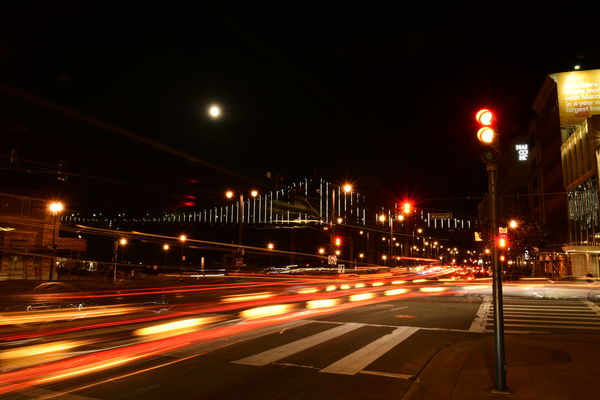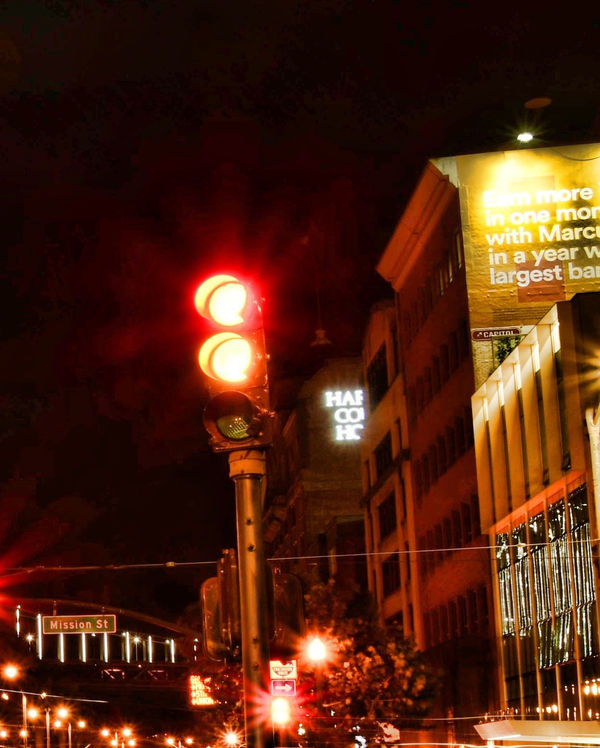Starburt Affect.
Oct 13, 2019 11:33:01 #
I am Curious about the attached photos, why is there a starburst/flare affect on most of the lights but not the one closes to me?
Oct 13, 2019 11:54:47 #
It's there. Just not as pronounced as some of the others.
--Bob
--Bob
dyximan wrote:
I am Curious about the attached photos, why is there a starburst/flare affect on most of the lights but not the one closes to me?
Oct 13, 2019 11:58:56 #
rmalarz wrote:
It's there. Just not as pronounced as some of the others.
--Bob
--Bob
I was just wondering why, I am sure it is basic physics/ and any optometrist/lens maker optical professional
could explain LOL.
Oct 13, 2019 12:00:32 #
rmalarz wrote:
It's there. Just not as pronounced as some of the others.
--Bob
--Bob
Agree with Bob. They are there, but not as pronounced. Just magnify the image and you will see it.
Oct 13, 2019 12:25:33 #
I see that, but what I am curious about is why are some more pronounced than others, the optics/physics?
Oct 13, 2019 12:35:49 #
The light sources visually closer to pinpoints of light vs. sources that are visually larger will cause this effect.
--Bob
--Bob
dyximan wrote:
I see that, but what I am curious about is why are some more pronounced than others, the optics/physics?
Oct 14, 2019 06:10:46 #
Is diffraction what you are talking about? You shot at f/18. At such apertures, starbursts are gonna happen.
Oct 14, 2019 07:00:23 #
Moisture in the atmosphere (think: very thin layer of fog) is forming tiny drops of water. Microscopic size. Surface tension pulls those small drops into a spherical shape. Light hitting these spheres bounces around inside them as it partially reflects off of the inside of the sphere. This is like the refraction inside a cut diamond which makes the gem sparkle.
The lights at a greater distance have more air between them and you, thus more possible refractions. Nearer lights mean less air/water vapor/droplets, and less refraction. The moon has a wide ring around it because its light goes through about 50 miles of atmosphere, with the last few miles having the most water and vapor.
The same moisture creates rainbows when hit at the right angle by bright sunlight. If the moisture freezes you have tiny ice crystals which can give the illusion of one or two extra suns or moons surrounding the actual one. I’ve heard these called ‘sun dogs’ and ‘moon dogs’, but those may be regional terms.
You can get similar effects from dust and soot around forest fires, volcanoes, and wind storms if the particles are very small and can stay airborne.
Also, dirt or grease on a lens element can cause light passing through it to refract improperly. By the time that lightbeam hits the film or sensor it has strayed a bit to the sides.
With film, light passing through the emulsion can also pass through the clear plastic film base and reflect back as an out-of-focus, and slightly less bright halo around bright (and overexposed) images. This effect is called halation, and many films are/were coated with a dark ‘anti-halation’ coating between the plastic film base and the light-sensitive emulsion. This dissolves out in processing.
The lights at a greater distance have more air between them and you, thus more possible refractions. Nearer lights mean less air/water vapor/droplets, and less refraction. The moon has a wide ring around it because its light goes through about 50 miles of atmosphere, with the last few miles having the most water and vapor.
The same moisture creates rainbows when hit at the right angle by bright sunlight. If the moisture freezes you have tiny ice crystals which can give the illusion of one or two extra suns or moons surrounding the actual one. I’ve heard these called ‘sun dogs’ and ‘moon dogs’, but those may be regional terms.
You can get similar effects from dust and soot around forest fires, volcanoes, and wind storms if the particles are very small and can stay airborne.
Also, dirt or grease on a lens element can cause light passing through it to refract improperly. By the time that lightbeam hits the film or sensor it has strayed a bit to the sides.
With film, light passing through the emulsion can also pass through the clear plastic film base and reflect back as an out-of-focus, and slightly less bright halo around bright (and overexposed) images. This effect is called halation, and many films are/were coated with a dark ‘anti-halation’ coating between the plastic film base and the light-sensitive emulsion. This dissolves out in processing.
Oct 14, 2019 08:07:29 #
Oct 14, 2019 08:52:33 #
Isolating the closest light and running it through an online app for HDR effect, you can see the starburst much better. The below article mentions image exposure and distance to subject, along with diffraction:
https://www.slrlounge.com/diffraction-aperture-and-starburst-effects/
.
https://www.slrlounge.com/diffraction-aperture-and-starburst-effects/
.
Oct 14, 2019 09:18:41 #
dyximan wrote:
...I am sure it is basic physics/ and any optometrist/lens maker optical professional
could explain LOL.
could explain LOL.
Yes, that's it. There are so many variables that some lights produce more of this effect than others.
Oct 14, 2019 09:44:44 #
In agreement with others, the flare is there just enlarge the image and you will see it.
If you want to control the starburst effect use a wider aperture but consider depth of field if that is important for your image.
If you want to control the starburst effect use a wider aperture but consider depth of field if that is important for your image.
Oct 14, 2019 10:06:06 #
dyximan wrote:
I was just wondering why, I am sure it is basic physics/ and any optometrist/lens maker optical professional
could explain LOL.
could explain LOL.
Not a physicist, but ---
The more of a point source, the relative brightness, and a smaller aperture (ie: 11, 16, etc) are all the largest contributing factors. Also, the number of aperture blades and the quality of the glass count, but not as much (in this case, 9-blade aperture, "L" glass for less flare, and, most importantly - a lens shade to keep the sunlight from directly striking the glass elements, also helping to reduce flare and avoid decreasing contrast).
I will sometimes deliberately incorporate "stars" in photos using the above guidelines. In this example, I waited until late in a hazy sun afternoon to avoid the stars overpowering the rest of the subject.

Oct 14, 2019 10:47:10 #
Linda From Maine wrote:
Isolating the closest light and running it through an online app for HDR effect, you can see the starburst much better. The below article mentions image exposure and distance to subject, along with diffraction:
https://www.slrlounge.com/diffraction-aperture-and-starburst-effects/
.
https://www.slrlounge.com/diffraction-aperture-and-starburst-effects/
.

Oct 14, 2019 11:26:15 #
If you want to reply, then register here. Registration is free and your account is created instantly, so you can post right away.








